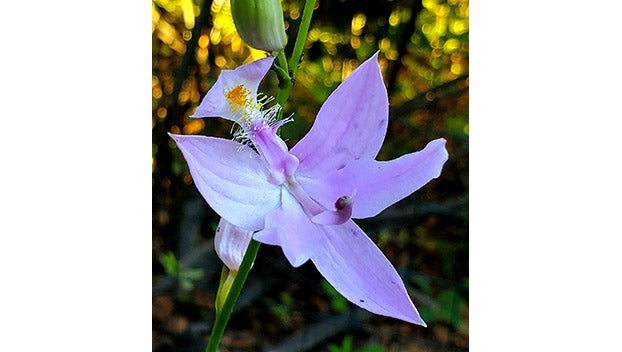Common grass pink: An interesting native orchid
Published 12:26 pm Friday, August 5, 2022

- The yellow hairs mimic pollen and trick visiting insects.
|
Getting your Trinity Audio player ready...
|
We tend to think of orchids as fragile, delicate plants requiring pampering, but they are extremely resilient and capable of growing in a wide variety of conditions.
Here in Virginia, we have many different orchids. We have parasitic orchids, such as autumn coralroot, which only grow 3- to 10-inches tall and are well disguised on the forest floor. Others, such as the pink and yellow lady’s slippers, are taller and have colorful, showy flowers.
They’re everyone’s favorite spring wildflowers. By the end of summer, the cranefly orchid flowers appear. Their solitary green and maroon leaves have long since disappeared.
Over time, orchids have developed various mechanisms for encouraging pollination. There are even orchids that are sneaky mimics. In some species not found in Virginia, the lower lip of the flowers resembles a female bee, so visiting male bees try to mate with the flower and, in the process, pollinate it.
Here in Virginia, we have the common grass pink (Calopogon tuberosus) that just finished blooming about a month ago. It may not be as showy as pink lady’s slippers or mimic a bee, but it’s beautiful and has its own tricks. It grows in bogs, fens, and seeps, on both acidic and basic substrates, and isn’t a common plant. In fact, the common grass pink is ranked S1S2 in Virginia – critically imperiled to imperiled.
The common grass pink has a grass-like leaf and stalks with up to 20 dark pink to magenta (or rarely white) blooms that open from the bottom of the stalk to the top. Each bloom has a hairy golden crest on the lip and no nectar spur.
And about those tricks — unlike many orchids, the common grass pink doesn’t have resupinate flowers. As the flower buds of most orchids develop, they exhibit gravitropic tendencies and the ovary starts to twist, thus causing the flower to be upside down.
What is the advantage of this phenomenon? It places the lip in a position to serve as a landing platform for visiting pollinators.
The common grass pink, however, uses a different strategy to achieve pollination. The golden hairs on the lip resemble pollen, and bees are attracted by the deception. The labellum, however, is hinged and swings downward, dropping visiting bees onto the column and brushing pollen onto the stigma. Another clever way to ensure that pollination is achieved.
While the common grass pink is critically imperiled in the wild, there are plants available from responsible growers of native bog plants. This orchid is very easy to grow and overwinter here.
Plant it and some pitcher plants in a large pot filled with a 50/50 mix of sand and peat moss. Water it only with distilled water or tap water that has been allowed to stand overnight to dissipate the chlorine. The growing medium should be kept moist at all times.
At the end of the summer, put the pot in a protected location and, if you remember, place some pine needles loosely around the plants. If you forget, no worries. The pitcher plants will remain green all winter, and the common grass pink will sprout in the spring.
Dr. Cynthia Wood is a master gardener who writes two columns for The Herald. Her email address is cynthia.crewe23930@gmail.com.





